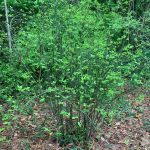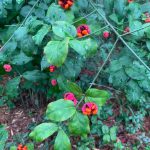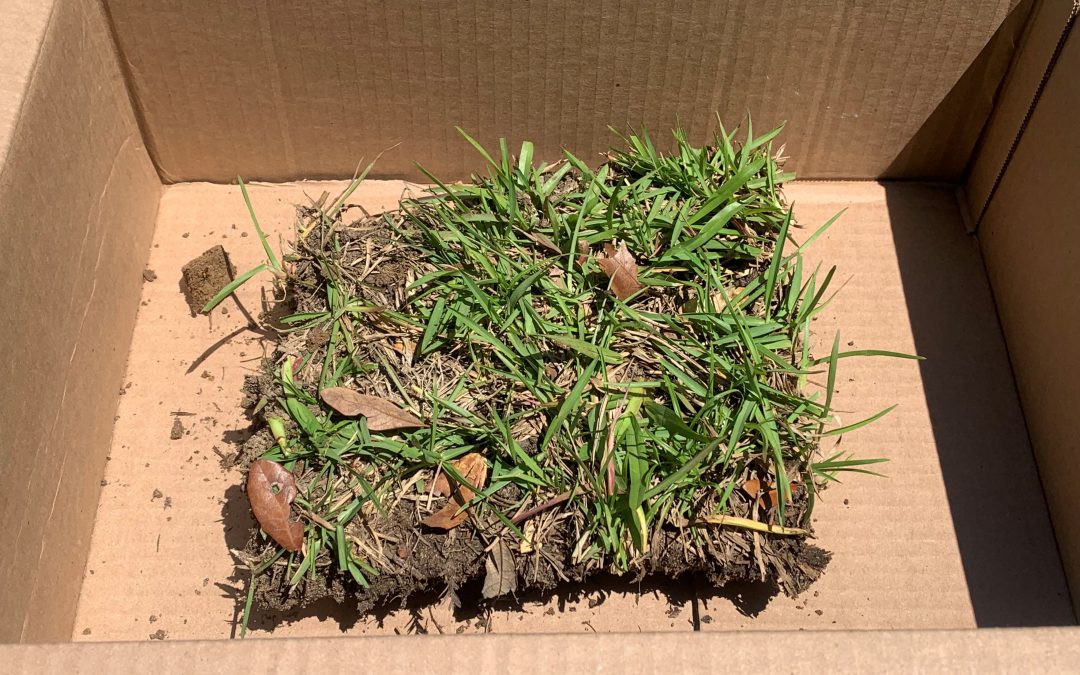

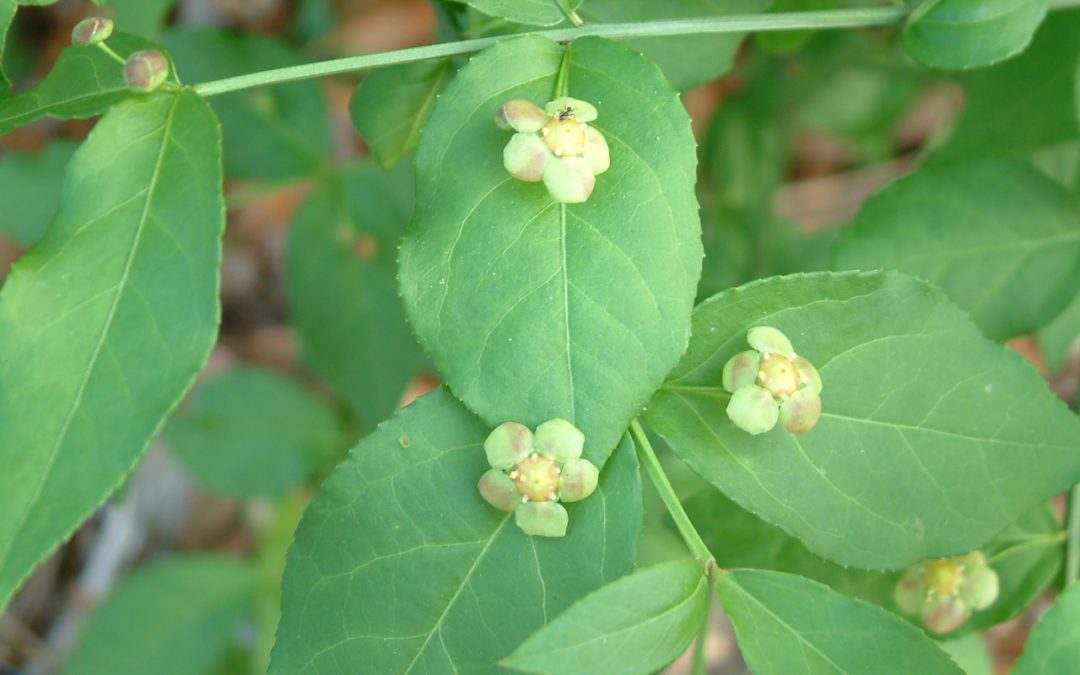
A Favorite Native Shrub
When I was first planting a landscape in 2001, I wanted to include some interesting native plants to provide a natural look for the back edges of the property. I was able to find a few less commonly sold natives from a small local nursery including a Bigleaf magnolia, Vaccinium, Sourwood, Cinnamon fern, and Strawberry bush.
Twenty years later, I am still enjoying these natives in my landscape and they are doing well despite my sandy, well drained, nutrient poor conditions. One of my favorites of this group is the Strawberry bush, Euonymous americana.
Strawberry bush is a deciduous shrub that grows about five feet tall. It has multiple stems with new stems forming each season. Since my yard is so dry, my clump is by no means out of bounds after 20 years of growth. Small pale green flowers grow from the nodes in spring. For most of the year, you forget about this plant until one day in the fall, you notice brilliant red fruits that split open to show orange seeds. Another common name is Hearts-a-bustin’.
Despite one of its common names, Strawberry bush is not grown as an edible for people but serves as a wildlife food source. Deer may enjoy leaves and twigs and many birds and small mammals will eat the seeds.
If you find a local nursery that is growing a few, consider adding Strawberry bush to a shaded spot in your landscape.
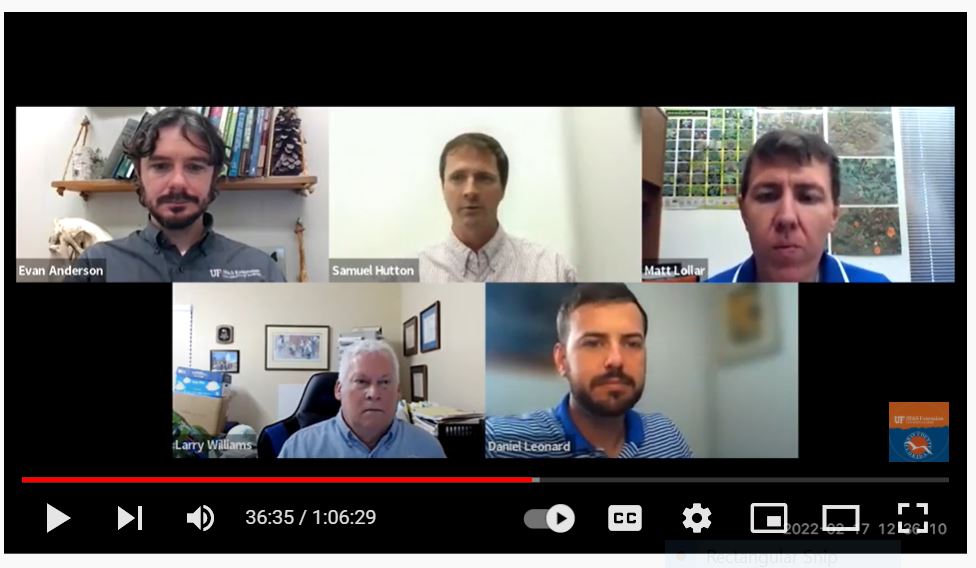
Growing Tomatoes: GIP Live Reference Materials
The February Q&A on Growing Tomatoes offered valuable tips for the home gardener to be successful with tomatoes in 2022. Below are the reference materials related to specific questions that were asked.
Let’s start out with the panels favorite tomatoes including hybrids and heirlooms.
Evan: Supersweet 100, Sungold
Larry: Amelia, Brandywine, Cherokee Purple
Sam: Better Boy, Tasti Lee, Sweethearts
Matt: Mountain Magic, Mountain Rouge, Bella Rosa
Daniel: Black cherry and Big Beef
Why are tomatoes red?
- Heat Brings Out Antioxidants, Increases Red in Tomatoes https://blogs.ifas.ufl.edu/news/2020/12/17/heat-brings-out-antioxidants-increases-red-in-tomatoes/#:~:text=For%20the%20study%2C%20researchers%20with,increased%20heat%20to%20stimulate%20tomatoes.&text=Carotenoids%20include%20pigments%2C%20one%20of,lycopene%2C%20which%20makes%20tomatoes%20red
Can we grow tomatoes year around?
- Veggies and Herbs Made in the Shade: A Growing Season Calendar for North Florida https://edis.ifas.ufl.edu/publication/HS1228
I have very sandy/loamy soil. Do I have a chance at successfully growing tomatoes?
- Soils and Fertilizers for Master Gardeners: Soil Organic Matter and Organic Amendments, https://edis.ifas.ufl.edu/publication/MG454
What is the best time to start tomatoes in North Florida?
- Keys to Growing Tomatoes in North Florida, https://nwdistrict.ifas.ufl.edu/hort/2017/02/25/keys-to-growing-tomatoes-in-florida/
If one grows in raised beds, should one rotate where in the bed tomatoes are planted?
- Cover Crop Publication links, https://edis.ifas.ufl.edu/entity/topic/cover_crops
If you plant tomatoes in mid-March, how long will they continue to produce fruit?
- Tomato Growing Tips, https://nwdistrict.ifas.ufl.edu/hort/2019/05/27/5-simple-tips-for-backyard-tomato-growing-success/
I’m thinking of trying hydroponic gardening on a few tomato plants this year. Do you think a 50/50 mix of perlite and vermiculite would be a good approach for a soil medium? I’d like to use 5-gallon buckets and keep maintenance to a minimum.
- Hydroponic Publication Links, https://edis.ifas.ufl.edu/entity/topic/hydroponic_production
What tomatoes grow best in inland Bay County? Coastal vs inland considerations.
Best type for all day sun (speak to tomatoes light requirements)
- Tomato Varieties, https://gardeningsolutions.ifas.ufl.edu/pdf/tomato_varieties_chart.pdf
What is the best tomato variety for Northwest Florida? I need one go-to variety for both regular tomatoes and cherry type.
- Tomato Production, https://edis.ifas.ufl.edu/publication/CV137
How to get more tomatoes, less vine?
- Light, Fertilizer and Cultivar Selection Affect Growth and Yield of Containerized Patio Tomatoes, https://mrec.ifas.ufl.edu/foliage/resrpts/rh_96_1.htm
My tomatoes get black on the bottom and rot. What causes this and how do I prevent it?
- Blossom End Rot on Tomatoes, https://blogs.ifas.ufl.edu/highlandsco/2020/04/17/blossom-end-rot-on-tomatoes/#:~:text=With%20Blossom%20end%20rot%2C%20tomatoes,become%20discolored%20and%20finally%20rots
Do tomatoes need a lot of water?
- Blue Dye Irrigation Test, https://edis.ifas.ufl.edu/pdf/SS/SS59400.pdf
Why do my tomatoes split/burst/crack while on the vine?
- Why Are My Tomatoes Cracking, https://blogs.ifas.ufl.edu/santarosaco/2013/07/07/why-are-my-tomatoes-cracking/#:~:text=When%20tomato%20plants%20have%20fluctuations,the%20skin%2C%20thus%20cracking%20appears
Any suggestions for how to handle especially wet years like last summer? My tomatoes really suffered.
- Dealing With Heavy Rains, https://gardeningsolutions.ifas.ufl.edu/care/weather/dealing-with-heavy-rain.html
How do I keep the leaves from getting dark spots that spread and kills foliage?
- A Series of Diseases in the Florida Vegetable Garden: Tomato, https://edis.ifas.ufl.edu/pdf%5Carchived%5CPP%5CPP121%5CPP121-10104936.pdf
How do you string tomatoes vine to a stake?
- Tomato Staking Techniques, https://mgsantaclara.ucanr.edu/garden-help/vegetables/tomatoes/tomato-staking-techniques/
What causes catfacing?
- Tomato Disease – Catfacing, https://plantpath.ifas.ufl.edu/u-scout/tomato/catface.html
Every year I’m having trouble with an amazing amount of insect infestations on my tomatoes & peppers I grow in containers. What can I do to help?
- Tomato Insect Pest Management, https://gardeningsolutions.ifas.ufl.edu/care/pests-and-diseases/pests/management/tomato-insect-pest-management.html
How do marigolds (which variety) or basil aid tomatoes?
- Marigolds for Nematode Management, https://edis.ifas.ufl.edu/publication/NG045
Please talk about save tomato seeds to grow. Some can’t afford to buy potted tomato plants.
- Saving Tomato Seeds, https://blogs.ifas.ufl.edu/escambiaco/2020/06/03/saving-tomato-seeds/
Can you add nutrients into the soil from last year’s tomatoes to reuse again this year?
- Compost Tips for the Home Gardener, https://edis.ifas.ufl.edu/publication/EP323
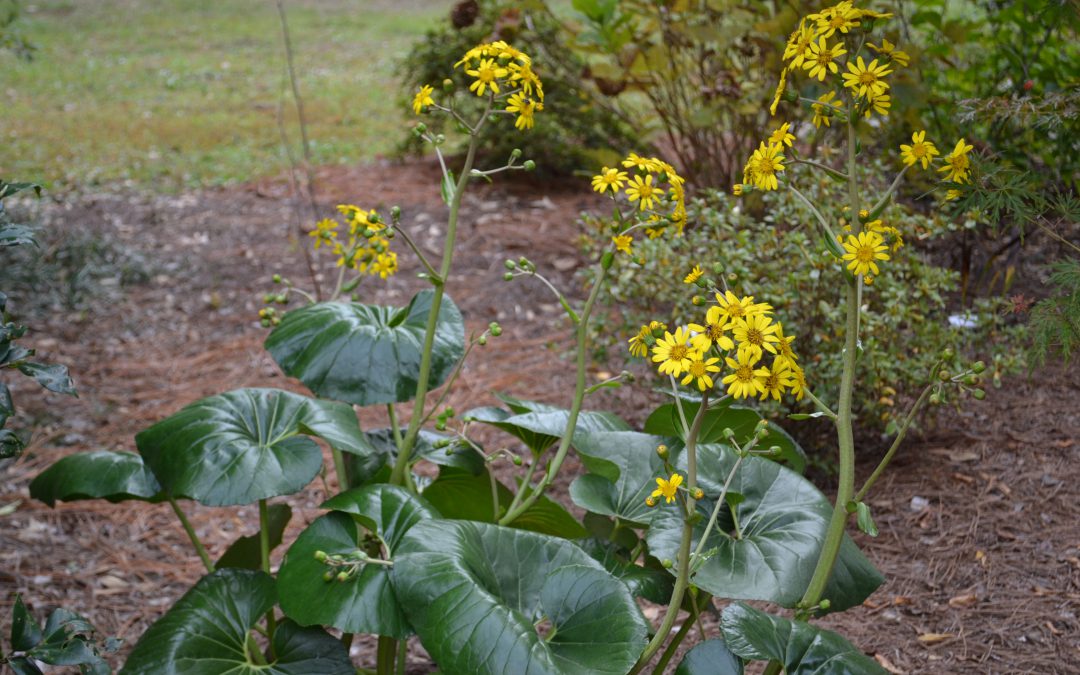
Leopard Plant is Made for the Shade
Several years ago the Escambia County Master Gardener Volunteers added a Leopard plant, Farfugium japonicum to the office demonstration gardens. This was a new plant for me and I was immediately impressed with look and performance of this plant in a filtered shade garden.
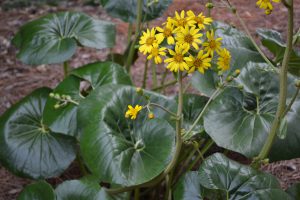
Leopard plant’s attractive leaves and flowers make it an accent in the shade garden. Photo by Beth Bolles, UF IFAS Extension Escambia County.
Although not native to the United States, Leopard plant make an interesting addition to the Florida garden. The large green leaves can provide a tropical look throughout the entire year since it is hardy in growing zones 7-10. An added bonus of the Leopard plant are spikes of bright yellow flowers in the fall and winter months. When you use Leopard plant as a mass planting, it certainly becomes the focus in our cooler months.
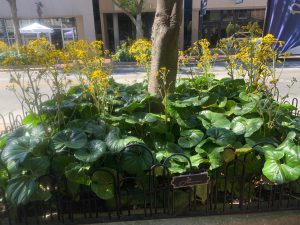
Leopard plant on display in Downtown Pensacola. Photo by Beth Bolles, UF IFAS Extension Escambia County.
There are many cultivars of Leopard plant and the selections with white (‘Argenteum’) or yellow (‘Aureomaculatum’) patterns on the leaves give the plant it’s common name. There are also cultivars with curled or crinkled leaves. All plants will thrive in partial shade with some additional water when rainfall is lacking. The clumps will continue to enlarge so you can often share a piece with a friend after a few years.
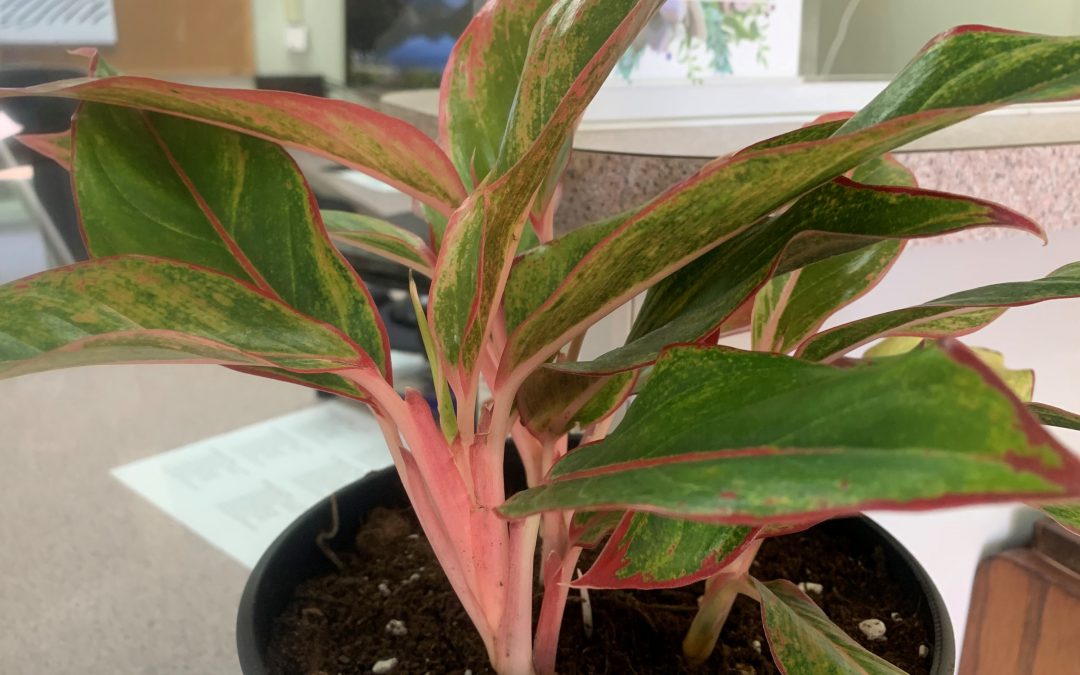
Video: Container Planting Tips
At one time or another, we have all added rocks or broken pieces of clay pots to the bottom of a container to improve drainage. This practice can actually have the opposite effect, causing the potting soil to stay too moist. Since many container-grown plants like good drainage, we end up with plant issues. Learn the method for potting up a plant that allows your soil to have good drainage with UF IFAS Extension Escambia County.

